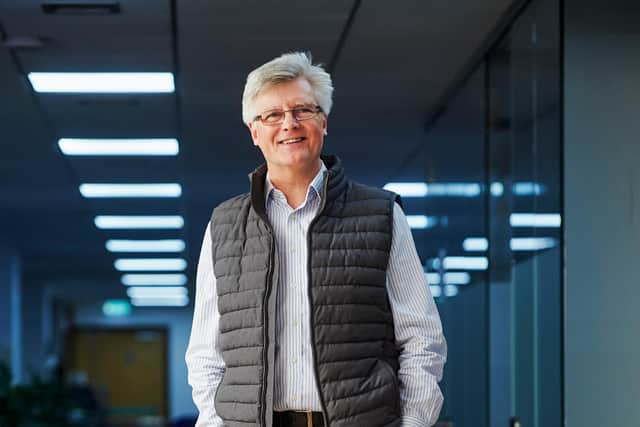The Big Interview: pureLiFi CEO Alistair Banham


Imagine a world where every light can transmit data – more reliably, more securely and with less interference than wifi. This is the future that Alistair Banham and his team at wireless communications company pureLiFi are striving to create.
In an unprecedented time when more of us than ever are working remotely and are heavily reliant on technology to communicate with friends and loved ones, sluggish download speeds and concerns over network security are becoming part of daily life. LiFi, which transmits data via the light spectrum, has unparalleled bandwidth and could help to relieve the pressures of more people logging on from home, says Banham, who became chief executive of the Edinburgh business in 2016.
Advertisement
Hide AdAdvertisement
Hide Ad“As we’ve moved to ensure that all of our employees have the option to work from home, we’ve seen first-hand how bandwidth in the home can pose a major challenge,” he says. “At the same time, lots of positive initiatives are springing up online, everything from virtual choirs to museum tours to first-run movies. Online activities like these seem destined to stick around once things get back to normal. It’s really made personal for us how LiFi will help to overcome the bandwidth challenge and enhance future life online.”
LiFi uses LEDs (light-emitting diodes) to deliver high-speed wireless connectivity, rather than the radio waves which support wifi. The technology that pureLiFi has developed can provide 1,000 times the bandwidth of the radio spectrum and may also have the potential to reduce infrastructure complexity and energy consumption, while improving security for users due to the physical restrictions of light.
“Light doesn’t pass through walls. If you’re in a conference room and the door’s shut while you’ve got LiFi in the light above your head transmitting through your PC or mobile device, someone outside cannot pick it up. If someone’s trying to get into that system they will need to be sitting directly underneath that lamp. That’s a big deterrent.”
Banham stresses that pureLiFi is not looking to replace wifi with its products, but complement it to better meet the burgeoning personal and professional connectivity needs of the world’s population. Global Market Insights forecasts that the LiFi market will be worth $75 billion (£61bn) by 2023, driven by the relentless demand for wireless connectivity thanks to fast growth in “smart” living gadgets, Internet of Things systems and virtual and augmented reality.
PureLiFi last year raised $18 million to support a mass roll-out of its technology to the consumer market. Banham describes the fundraise as a “watershed moment” for LiFi technology. Backers include Temasek, an investment company headquartered in Singapore, and the Scottish Investment Bank. The mammoth fundraise will allow the company to further develop gigabit LiFi components and make them available in integration-ready forms to fit mobile devices manufactured by its partners, says Banham.
“The key thing about that investment, besides it signalling that we have strong support from investors which is great, is that we need that money to help us take the next step in our leadership for LiFi technology. We need to make sure our products are ready for full roll-out and volume production but also we’re developing the next generation of devices – and that takes quite a bit of money and research.
“This gives us a bit of breathing space. And also we need to expand a little bit to make sure we’re working with these bigger partners. That will help drive revenue because we’re delivering products to customers for evaluation and longer-term design.”
The Edinburgh firm’s list of industry partners features several household names. It has collaborated with device manufacturers, such as tablet and PC producer Getac, to have LiFi designed into commercial laptops, tablets and mobile devices. Projects have also included holding a high-speed connectivity trial at the Slough headquarters of telecommunications giant O2 Telefonica and teaming up with aerospace and defence group Astronics Corporation to test the use of LiFi on aircraft.
‘The father of LiFi’
Advertisement
Hide AdAdvertisement
Hide AdPureLiFi was founded by “father of LiFi” Professor Harald Haas, now chief scientific officer, and Dr Mostafa Afgani, now chief technology officer, in 2012 as a spin-out from the University of Edinburgh. It maintains a close relationship with the institution.
“The University of Edinburgh is very important to us,” says Banham. “We work with them to see if we can get new recruits coming in, and we work with the LiFi Research and Development Centre, which is led by Professor Haas. They look at some ecosystem developments that could use our components.” It’s of mutual benefit, exposing academics and students to real-world applications as well as helping pureLiFi to determine its direction.
The business last year announced a step change in its strategy, shifting its focus from LiFi systems to LiFi components, an announcement made at the Mobile World Congress 2019 in Barcelona. The trade fair, which was unable to take place this year due to the coronavirus outbreak, is the world’s largest exhibition for the mobile industry. It was here that pureLiFi demonstrated gigabit LiFi integrated into a laptop for the first time.
“That was the biggest defining moment for me, when our team launched that miniature device last year for integration with mobile devices,” recalls Banham. “We started at 100 kilobits and now we’re at gigbabits – we’ve not only increased the data but improved the size of the products. The initial products were pretty big, bulky, good for testing, but we now have miniature components which are ready for integration in mobile devices.
“At the congress last year we demonstrated that to the world in a very noisy radio frequency environment, where you can’t get on to the wifi, you can’t make calls because the networks congested, there’s lots of interference. We were showing our customers a system that demonstrated one gigabit of data transfer without any boxes to protect it from interference. That was a defining moment because customers started taking more notice.”
The LiFi capital of the world
Communicating data through the light spectrum is not a 21st century idea. It was initially conceptualised by renowned Scots-born inventor Alexander Graham Bell in 1880 when he created the photophone, a device capable of transmitting speech via a beam of light. It was 130 years later when Professor Haas demonstrated data transmission using the light spectrum and coined the term LiFi. Now this functionality can be integrated into phones, laptops and lamps, trafficking huge volumes of data.
“In terms of rolling it out in buildings or houses we can replace current LED fixtures with LiFi-enabled fixtures. And we’re working with groups like Wipro [an Indian multinational] to do this. You do need the electronic infrastructure and connectors, it’s not just a case of switching out the lights,” explains Banham.
He became aware of the technology in early 2016 and joined pureLiFi as CEO by June of the same year. “I hadn’t heard of it before. As I started to dig in to what this technology could deliver, given that the spectrum is so wide you can deliver such high data rates, I just thought: ‘Wow, I really want to get involved’.
Advertisement
Hide AdAdvertisement
Hide AdIt’s almost a legacy thing – you develop this technology so you can take it across the planet. Maybe it becomes part of our daily life, it’s another way to support the massive amount of data that we as consumers and engineering teams and manufacturing companies are moving around. I can remember exactly thinking: ‘This is for me.’”
Banham has more than 30 years of experience in the semiconductor industry, with leading roles at Philips and Wolfson Semiconductors. He has helped grow pureLiFi to around 35 employees and counting with business development functions in Taiwan and the US.
“Edinburgh, and Scotland, is a massive hotbed for semiconductor companies who require a lot of talent so trying to get the right skills has been a challenge, especially in the optic space because that is critical to our products. We’ve managed to get the right people in, although sometimes it takes a little bit longer than we’d like,” he says.
A key draw is the novelty of pureLiFi’s offering, says Banham. People like a challenge, and his ambitions don’t end with the company; his vision is to foster an entire chain of LiFi activity in the Scottish capital.
“People like innovation, to learn more, to build a new kind of world which is unique, so they want to get involved. The dream is to make Edinburgh the LiFi centre of the world. You’ve got the University of Edinburgh and pureLiFi here. We can create an ecosystem – why not? People from all over the world will come to Edinburgh because of the expertise in LiFi.”
Comments
Want to join the conversation? Please or to comment on this article.
